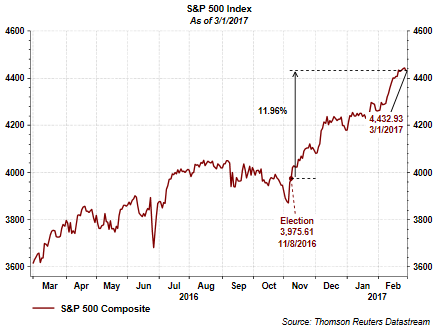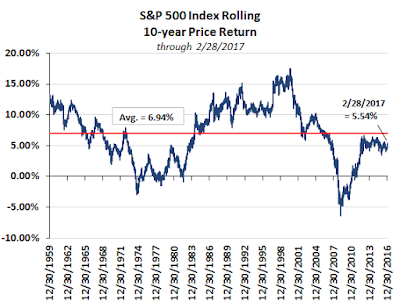Time To Reduce Ones Equity Exposure?
The U.S. stock market has been on a steady climb higher since the November election. From 11/8/16 to 3/1/17 the S&P 500 Index has moved higher by 11.96%. This double digit return in a short period of time has some investors asking if this is an appropriate time to reduce equity exposure.

An initial action investors can benefit from at this point in time is to evaluate the overall asset allocation in light of the equity market's strong advance. The move higher in stocks may have resulted in ones allocation to be overweighted in equities. This should be reviewed in conjunction with ones weighting in cash and shorter term bonds. Is there adequate cash and/or short term investments to support cash needs in the event the equity market does experience a pullback? This cash and short term investment bucket should be sufficient to sustain cash needs over a time period that will allow stocks to recover without the need to sell equities while they are down. As a rule of thumb, this short term bucket might equal two or more years of withdrawal needs.
The second factor to look at is how significant has the recent move higher in stocks actually been compared to history. As the below chart of the S&P 500 Index shows, the current 10-year rolling price return is just below the market's average looking back to 1950.

Looking at the S&P 500 Index total return since 1928 also shows the ten year period return from 2007-2016 is below the longer term (1928-2016) return of 9.52%. So in spite of the strong equity return since the financial crisis, the return over the past ten years has been quite a bit below average.

One factor at play in the market currently is positive upside momentum (clearly seen in the first chart above) that seems to be feeding on itself. LPL Research looked at past years since 1950 when both January and February of a year were positive. What the table below shows is in 24 of 26 years, the S&P 500 Index was higher in the remaining ten months. In other words, a strong start i na year generally leads to a strong full year return.

Lastly, we are seeing improving fundamentals for companies, specifically, a resumption of mid-single digit earnings growth in the fourth quarter of 2016, with double digit growth expected in 2017. Recent economic data has been positive and suggestive of an improving economy as well. An improving earnings picture and improving economic data tend to be positive for stocks.
In conclusion, a pullback will occur and does seem overdue keeping in mind the average intra-year stock pullback is about 14%. With the strength of the market's advance since the election, now is a good time to review the overall allocation across ones investment portfolios. If equity exposure is higher than ones comfort level, no one went broke taking a little profit or trimming equity exposure a little bit.
Disclosure: None.




Thanks for sharing